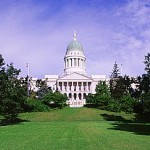Maine, a Role Model
Efforts to ban specific toxic chemicals like Deca and BPA make a difference. The reality, however, is that there are more than 82,000 different chemicals in production. Dealing with harmful chemicals one by one could take a lifetime. Or more. A more effective way to protect ourselves from exposure is through policy that takes a precautionary approach. This framework requires thorough evaluation of chemicals so that unsafe chemicals don’t make it to the market in the first place and promotes the use of the least toxic alternatives.
Last April, Maine took a huge step in this direction last April with the passage of the Kid-Safe Products Law. This landmark law will reduce children’s exposure to chemicals that based on “credible scientific evidence” may be harmful to our health. PPNNE worked with Alliance for A Clean and Healthy Maine on the bill and applauds its passage.

Maine's State House
The Kid-Safe Products Law applies to children’s products, but don’t just think of sippy cups and toys. ‘Children’s products’ are defined broadly to include products to which kids are exposed. While exceptions are written in for some everyday products it is clear the bill was written with children’s safety in mind. For example, while food is generally exempt from the law, the law does apply to baby food and infant formula. Furthermore, the bill specifically targets chemicals that are known or likely reproductive or developmental toxicants. It also singles out endocrine disrupters, which are frequently linked to reproductive health problems.
Roughly one year later implementation is underway in Maine, and the law has become a national role model of sorts.
At the federal level, the Toxic Substances Control Act (TOSCA) governs chemical safety. Sort of. The law was passed in 1976, and since then the EPA has required testing of less than 2% of chemicals in production and issued regulations for only five. That’s five chemicals, not five percent of chemicals. Keep in mind roughly 62,000 chemicals were in production in the 1970s and roughly 82,000 chemicals are in production now. TOSCA leaves a lot to be desired in terms of chemical safety.
Hannah Pingree, speaker of the Maine House, and Chellie Pingree, her mother and a Congresswoman from Maine, are urging lawmakers to use the Kid-Safe Act as a blue print for reform in of federal regulation. Considering the common sense approach of Maine’s law, and the general inefficacy of TOSCA, Washington would do well to follow in Maine’s footsteps.
Keep Reading...
Tags: Maine, Planned Parenthood of Northern New England, PPNNE
